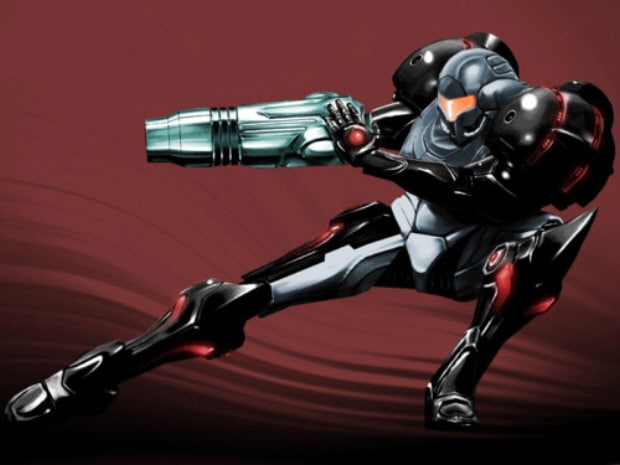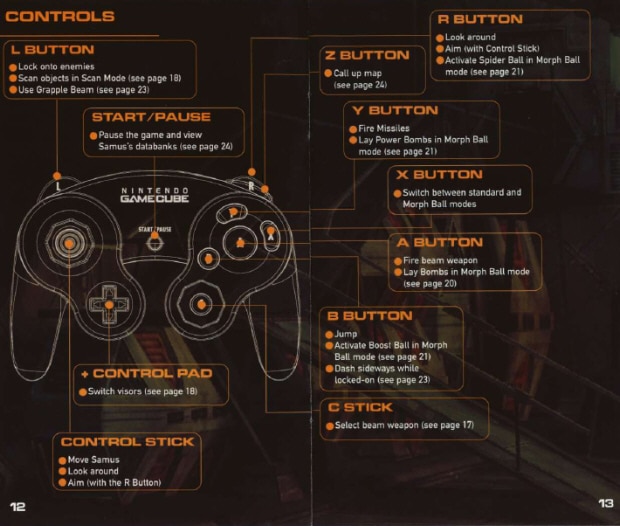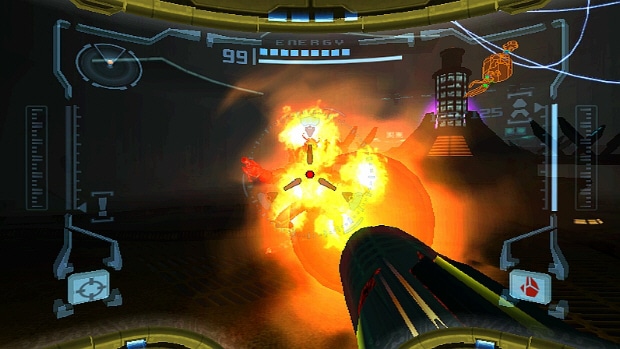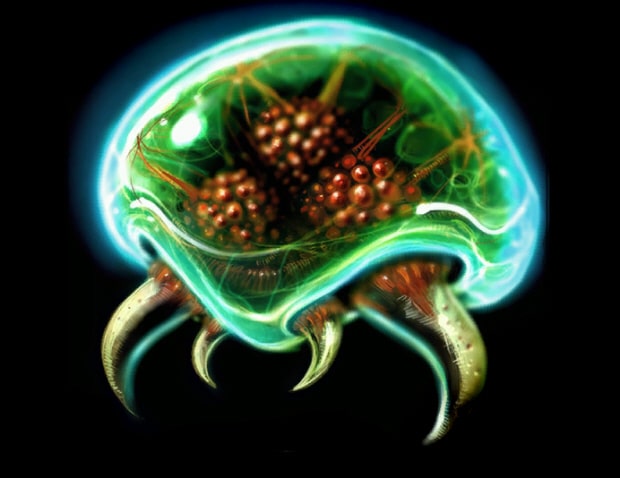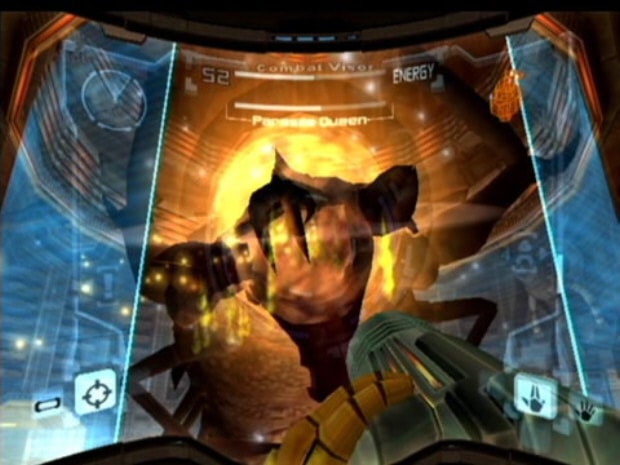
Metroid Prime was Nintendo’s first modern shot at the Metroid series. Nintendo had tried but failed to bring the series into the “modern” era back on the Nintendo 64, as a follow-up to it’s beloved creation of 2D gaming perfect, 1994’s Super Metroid.
However Nintendo’s Shigeru Miyamoto, creator of Mario and Zelda and the guy who would take over as exectuve producer after the death of Metroid creator Gunpei Yokoi, has stated in interviews that he could not figure out a proper way to bring Samus into the third-dimension.
The adventures of bounty hunter Samus Aran have a completely different feel than that of Mario and Zelda, and that is likely where Miyamoto fell short. Thus, Metroid would not return to the videogame scene at all during the 32/64-bit era, with the exception of a cameo appearance with Samus as a playable character in the four-player brawler Super Smash Bros., which was a huge hit.
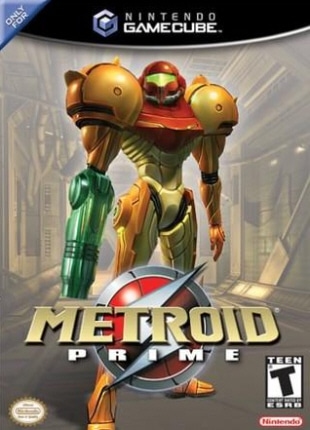
During these dark times for Metroid fans, Nintendo eventually bought out the Texas-based developer Retro Studios, at a time when they made a string of developer acqusitions in order to supercharge development on their then-new 128-bit console, the GameCube. Which would succeed the Nintendo 64 with a graphical prowess that matched that of Sony’s PlayStation 2 and Microsoft’s Xbox.
But instead of making a 3rd-person Super Mario 64 platform-style action adventure, Nintendo’s Shigeru Miyamoto did the unthinkable and chose to make Metroid Prime a first-person-perspective, “see through her eyes” game. This news created shockwaves throughout the industry and led fans to cry out in agony that a bunch of wayward, cowboy, horse-riding American Yankees were going to destroy their beloved Metroid by turning it into a first-person shooter! And the first actual showing of the new Metroid game at E3 2001 did not relieve those fears.
However, on November 17, 2002, Nintendo finally released Metroid Prime to the American masses after many delays. And as you probably already know, fan’s perceptions and fears of the game were as wrong and unfounded as could be. Samus, had returned.
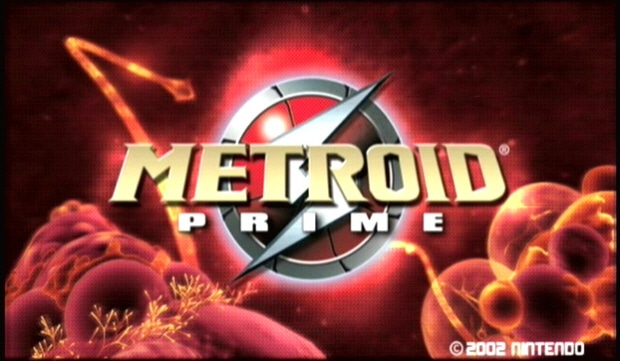
System: GameCube
Also Available On: Wii as part of Metroid Prime Trilogy
Released: USA November 17, 2002 – EUR March 21, 2003 – AUS April 3, 2003 – JAP February 28, 2003
Players: 1-Player
Genre: First-Person, Action Adventure
Save: 2 Blocks on GameCube Memory Card. 3 Save Files.
Accessory: Links with Metroid Fusion via a GameCube Game Boy Advance link cable. Unlockes the original Metroid and a Fusion suit for Prime play.
Online Support? No
Developer: Retro Studios
Publisher: Nintendo
Country of Origin: United States
Rating: T for Teen because of “Violence”.
Metroid Prime catches your attention right off the bat with what is, in my humble opinion, one of the best and coolest intros of any game ever.
The intro starts the mood of right with music that is creepy and totally sets the Metroid mood. The music is all new and yet a total throwback to the past Metroid games without treading on already established territory.
Not only is the music awesome, but the menu screen graphics are as well, because it is set INSIDE a Metroid! As you move to different menus, the viewpoint will switch to different sides of the Metroid’s innards. Flat out awesome it is.
It’s also worth noting that Metroid Prime Trilogy cuts this intro out entirely. For shame!
Here is what the menu looks like (no audio):
And here is the menu audio (not high quality):
Here is the storyline for Metroid Prime, taken from the game’s instruction booklet:
Metroid Prime Story Instruction Book Scan 1 – The Chozo

Metroid Prime Story Instruction Book Scan 2 – The Space Pirates

The storyline of Metroid Prime takes place between that of the first Metroid and Metroid 2: Return of Samus for Game Boy.
Although there is some depth to the storyline and the world of Prime, the story doesn’t really play into Metroid Prime in any meaningful sense in a way where you could tell someone the story.
Instead, the story is mostly regulated to exposition that is “hidden” view, and is only viewable via Samus’ Scan Visor, which allows you to scan objects and enemies.
This is one area where Metroid Prime takes a gigantic leap into new, uncharted territory that is completley different from that of past Metroid games, and takes advantage of the new first-person viewpoint.
Scanning is interesting. It’s a really cool feature because it allows you to scan the environment and read more information about what’s around you. Kind of reminds me of “checking” the environment like in Resident Evil remake or Resident Evil 2. Which is a good thing.

Because it means that all of those environment objects and pieces of the landscape are not just there for show, but you can actually read about them! It really makes the world come alive in a way that I wish more games would take advantage of. What’s more, a lot of objects are logged and you can look up all the different enemies and objects you’ve encountered via the Main Menu.
Scanning is also cool because all of that exposition is optional! Scannable objects are color-coded orange or red. Orange means you don’t HAVE to scan it (although you are rewarded for scanning in the end), while Red means you do need to scan it to proceed (like you might need to scan a computer terminal to activate something and proceed, so it’s Red in your Scan View).
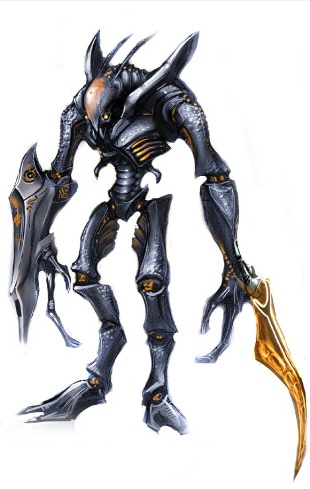
As you play you will uncover two forms of jounrals: Space Pirate logs and Chozo Lore. The Chozo Lore discusses the mythology and beliefs of the Chozo, the ancient bird-people who raised Samus Aran and created her Power Suit. She is known as “The One” or the “Newborn” to them and they talk of her as their savior. They also discuss “The Great Poison”, which is an all-new substance that you will encounter in the game known as “Phazon”, which the Chozo refer to as “The Great Poison” which has polluted their once-great planet.
The Space Pirate Logs let you view the world of Tallon IV from the viewpoint of the enemy. In their logs they will discuss their upcoming creations (i.e. bosses you will soon face), what they plan to do with the world and the Chozo Ruins that remain, how they will break into the energized core of the planet, and eventually, will discuss Samus herself whom they consider their greatest threat. They also term the word “Phazon Madness” to describe the effects of Phazon on creatures and the Space Pirates themselves.

Anything you scan will also be put into your Log Book, which is contained in the Main Menu (hit Start or 1 Button on Wii). Here you can read about each and every Power-Up, Item and Ability that Samus has gained, as well as about all of the Creatures (enemies and bosses), Research (Mechanical Objects and Items from Save Point Stations to gun turrets to the Energy Balls that refill your health and are left behind when you destroy an enemy), Artifacts (Chozo Artifact location hints), Chozo Lore and Pirate Logs (journals left behind by previous/current peoples on the planet). All this information can be read at any time, and if you hit the Left Trigger in the Main Menu you will also enter the Options screen, where you can toggle HUD Opacity, switch a few buttons around, and other things.
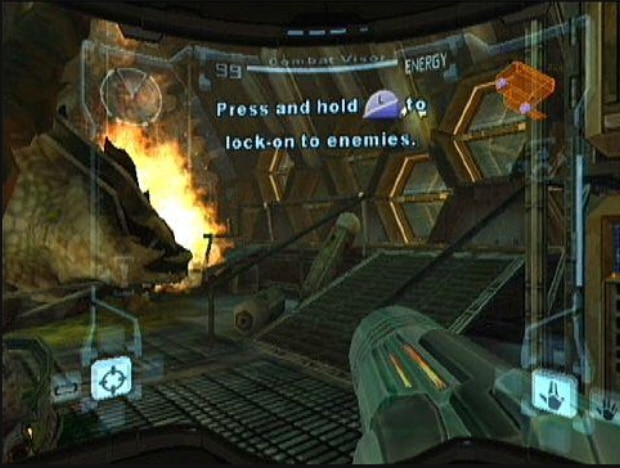
In Metroid Prime, Samus first starts out on a Space Pirate facility orbiting the planet Tallon IV. This area serves as a sort of tutorial (although you can die) and will get you acclimated with controlling Samus and using some of her more advanced abilities . . . abilities which are subsequently stripped from you. And in true Metroid fashion, you will then have to find these power-ups and build Samus from a weak warrior into a force to be reckoned with.
This is pretty interesting because even some mid-game abilities are accessible in the beginning portion, which does a good job of really allowing players to grasp how Samus will be controlled and the kinds of things she will be doing, from the Morph Ball to the Grappling Beam, later on.
The controls in Metroid Prime are perfectly fitted to the GameCube controller (which makes a somewhat awkward and cumbersome transition to the Wii Remote & Nunchuck in Metroid Prime Trilogy).
Here is a layout of the controls:
One of the biggest changes in Metroid Prime from other first-person games is the fact that you cannot strife (unless you lock onto an opponent, in which case you can circle around them and do a small dash-jump out of their way) and the fact that you cannot look up or down in any direction unless you stand still and hold the R Button, which puts you in aim mode. The real reason for this is due to Samus’ Lock-On Mode, which is an extremely efficiant ability that allows you to switch from foe to foe by pressing it. This means that you can hammer on the A Button (which rapid-fire shoots Samus’ Power Beam) and keep pressing the L Button to clear out a whole room of foes in seconds.
Although one might think that this makes the game too easy, it in fact doesn’t, and is simply fun. And isn’t that why you play videogames?
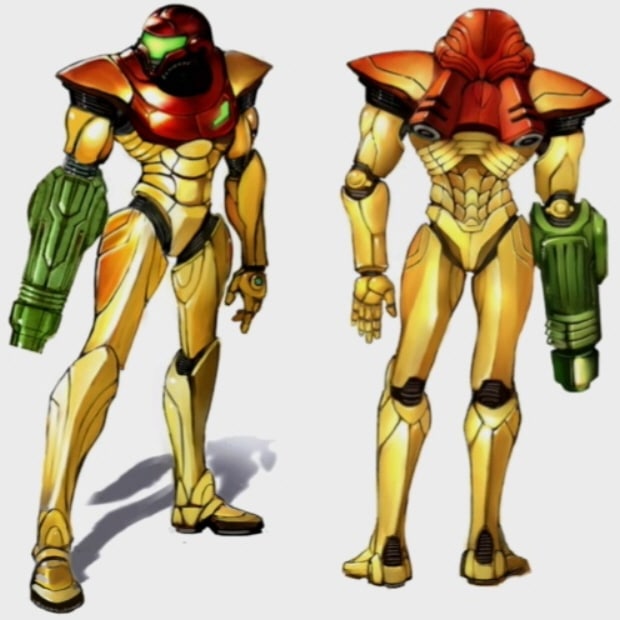
It’s worth noting that the whole “can only look around while standing still” thing DOES NOT apply to Metroid Prime 1 in Metroid Prime Trilogy, which is one of the biggest changes from the GameCube version. In that version you simply point the Wii Remote where you want to look and Samus will look in that direction.
It’s also nice to have a quicklink to your Map, which is easily accessible by pressing the Z Button (the 2 Button on the Wii Remote for the Wii version). The map works wonders in this game because the game world is very large and it is pretty easy to get lost. The map is actually 3D and even the layout of the rooms is represented! It’s definitely one of the best video game maps out there.
In Metroid Prime, you make your way through several unique and distinct environments on the planet of Tallon IV. All of these rooms and chambers are connected by doors that can be opened with a blast from a specific gun. As you make your way through the game you will encounter doors that cannot be opened and areas that cannot yet be accessed until you have powered Samus up with another ability.
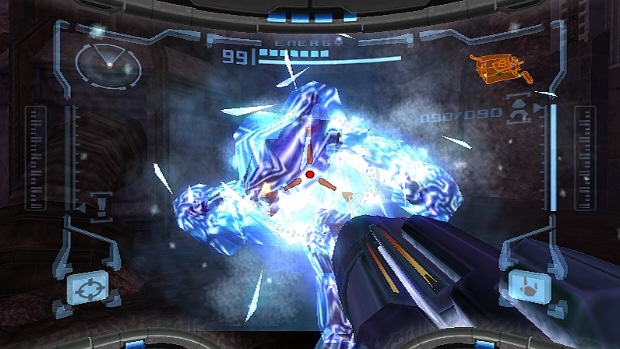
As you make your way through the environments, you will encounter native creatures (which are necessarily hostile) and enemies who ARE out to destroy you. You can destroy these enemies by shooting them with one of your four Beam weapons or kill them with Bombs or Missiles. In addition to regular enemies which are designed as if they were native creatures of the environments, you’ll also encounter much more powerful enemies that are part of the Space Pirates. These guys are much tougher than normal enemies and attack in packs.
Eventually you’ll face off against Giant Bosses, a few are native to the world but most of them are Space Pirates of one form or another. These bosses can be much more difficult and are generally massive in size. Defeating them will almost always result in a new Power-Up, which will give you a new abiltity that will allow you to access areas you couldn’t access beforehand.
This progression will be familiar to fans of the previous Metroid games, as The Legend of Zelda pioneered the whole power-up collection system along with exploration, and Metroid took it in a whole other direction but did it for action games.
What is also carried over from Metroid’s past are additional Items which increase the number of Missiles you can carry by 5 (as well as another power-up) and Energy Tanks. These increase the number of health you have by 99 units, represented as boxes in the upper-left hand corner of the screen.
Your screen HUD display also features your missiles on the right, what Power-Up or Visor you have selected, a mini-map in the upper right, a radar that shows approaching enemies, and a “Threat Detector” that rises as you approach something that will harm you.
What also will be familiar in Metroid Prime is all the little touches to the gameplay that make Metroid such a unique game.
Available from the beginning and one of the most used elements is Samus’ Morph Ball. This allows you to roll into a perfect sphere, which can then allow you to roll into small areas that you can’t enter any other way. You eventually will gain Morph Ball Bombs, which you can use to not only launch yourself in the air but also allows you to break certain blocks in the floor or walls, allowing you to access hidden areas. The Wii version also has a new feature in which you can perform a hop while in ball form (called the “Sring Ball” in previous games, where it was a Power-Up you had to find) with a flick of the Wii Remote.
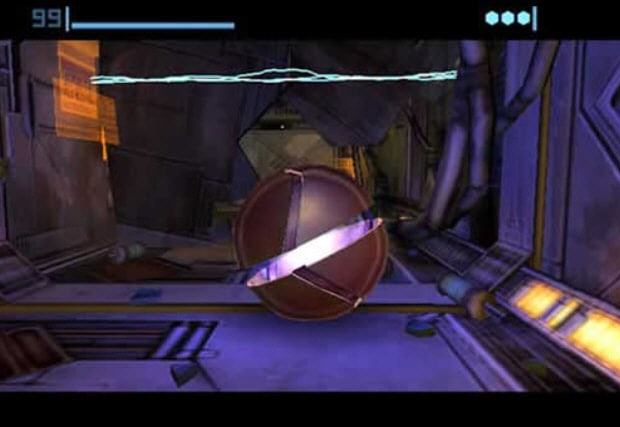
You can even do the token “Bomb Jump” technique in Metroid Prime, which you lay a bomb, and then lay another one just as that one explodes and then when the first props you into the air, lay the third bomb. This will propel you once more. This technique was made famous in Super Metroid where you could literally infinitely bomb yourself into the air and to the ceiling if timed right. In Prime you can only lay up to three bombs, but you will use this Bomb Jump technique to reach a few specific Items which are otherwise unreachable.
Although Metroid Prime is awesome from beginning to end, the sense of “power” that you feel as you discover new Power-Ups is almost unparrelleled in gaming.
Once you find the Space Jump Boots for example, which allow you to double jump, you almost feel like a whole new character! The agility that the boots give you and the ability to leap so much farther and higher than before makes the entire game feel different.
As soon as you get them and take that first leap, you will be so impressed with your newfound power that you will ZOOM through areas in literally seconds. Whereas before you may have needed to roll into a ball, go through a crack on the floor, and make it through several enemies that spit you back out if caught . . . now you literally can just LEAP over it. Skipping the entire thing! THAT, my friend, is incredible design. And this does not only happen once. There are at least three Power-Ups that COMPLETELY change the game once you have gotten them. I’d love to speak of them, but I’ll hold my breath for anyone who hasn’t played it (although one of them was actually already mentioned).
And that brings us to design. The design of the world of Tallon IV is impeccably detailed with each room being 100% unique from the last, you will find no repeats! This alone is worth extreme kudos as it is very easy for developers to “cut-corners” by re-using elements, but not so here.
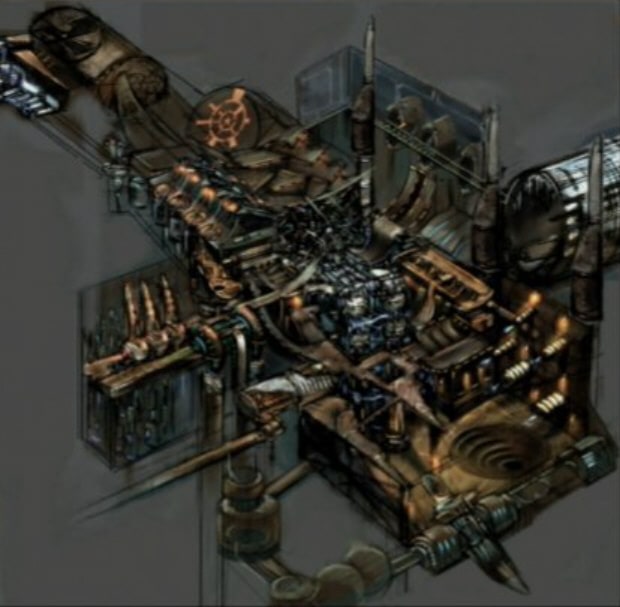
Secrets and areas you can’t enter “quite yet” abound around every corner as well. This makes you want to explore the whole world again everytime you get a new Power-Up and thus a new ability. Often times you will even remember where to use your new piece of equipment to get further in the world. Which means that as soon as you get this new ability, you will have fun going back to another previously explored area and doing what you couldn’t do before.
And these environments are not just there for show. There are hidden scanable points like Chozo Lore entries or Pirate Logs EVERYWHERE, and there are literally secrets, hidden areas, and new paths tucked away in every corner that only the diligent will find.
Many rooms also have puzzles of sorts, where you will have to use a bit of brain power to figure out how to reach an item or what you must do to activate something. I wouldn’t necessarily call these puzzles, because they aren’t difficult and are pretty easy to accomplish once you realize what to do. But this definitely makes Metroid Prime a thinking man’s shooter.
And the environmental puzzles are very much what you would expect from a 3D reinterpretation of Metroid. Often times they include blowing up a piece of the environment. You can even scan rocks and such to find out what type of alloy they are made of, and certain ones can be broken by certain types of weapons.
Many puzzles involve using your ball form to roll into a device, and then bomb yourself to activate it or use another ability to raise and lower bridges, activate platforms, etc.
And not only are the environments fun to explore (and worthwhile as you will gain additional Missiles and Energy Tanks, etc. for you troubles) but the design is amazing. While the world IS indeed very large and has multiple themed areas including an Ice and Fire world (which are excessible via elevators, just like in the original game), while you at first will get lost, eventually you’ll really learn your way around. Which is good design. And it doesn’t end there, eventually you’ll find that all of the world is interconnected, and you’ll find shortcuts to certain areas.

As you get further into the game you will be making your way through more and more exotic areas, and will have to use more and more abilties. You will eventually gain additional viewing options via your Visors. You start out with two (normal or “Combat View” and your “Scan Visor”) and will earn others as you progress.
These views come complete with their own awesome, stylized look that really makes this game pop, and makes them fun to use.
One of the best areas where Prime excels is in pacing. One of my favorite moments and a good example of this, is the great sense of relief you feel after escaping out from the first lab area where you fight the deadly Space Pirates for the first time.
This area is as difficult as it gets even with the lights on when you first make your way throught it. However once you reach the end, the place goes all dark and you gotta use your newly acquired Thermal visor to navigate through the darkness. Using the heat eminating off of enemies and other objects to make your way back to the entrance.
The place is connected by various tunnels and doors on the floors or roof, so that it is easy to get lost on your way back, and much easier in the dark! In fact if you turn your visor off, you will find that you can’t see ANYTHING.
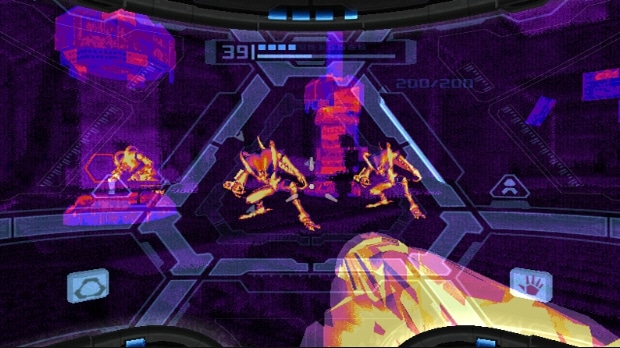
Making things more difficult is the fact that the Thermal Visor allows you to slightly see through solid objects (so you can see a door on the other side of a wall, for example), making it even more confusing as you navigate through the various tunnels and doors. By the time you get back into daylight you breath a HUGE sigh of relief.
Very few games can give you this feeling of relief and triumph (I DID IT!) and do it so well. Both with the design of the area and progression . . .. . Where you battle your way through all the way to the end, then have to go back, but seeing it through a whole new perspective that changes everything. It truly is making the best use of what is already there, but doing so in a way that actually works and hightens the tension.
Believe me, after doing this part you will NOT want to encounter another Space Pirate as long as you live. AND THEN, directly after, the game throws a titanic boss at you! So is the design of Metroid Prime. But when you get done with that boss. You look around and say . . . . “This game is freakin’ bad ASS!”
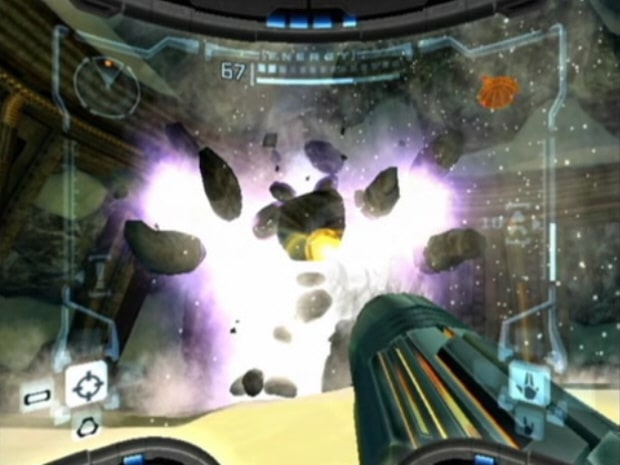
There are a few neat touches that are throwbacks to previous games. There aren’t a lot, but the game is very much in the spirit of its predecessors. If you are a fan though, you will notice a few references or areas that are similar to past games. There is a derilect Space Pirate Ship, which will remind fans of the Wrecked Ship area of Super Metroid. The Tallon IV overworld is mossy and green, which should remind fans of Brinstar. Norfair, of course, is in the game. And along with the lava you get a remix of the same Norfair theme seen in Super Metroid.
There are also more obscure references in the Chozo and Space Pirate logs you find referencing SR388 (the Metroid’s home world, which you visit in Metroid 2 for Game Boy and is referenced in the instruction manual of the original Metroid. You will also encounter different kinds of Metroids instead of only the main kind, which is a first since Metroid 2.
Finally, of course, there are lots of classic Power-Ups you know and love from the original which make their return in Metroid Prime.
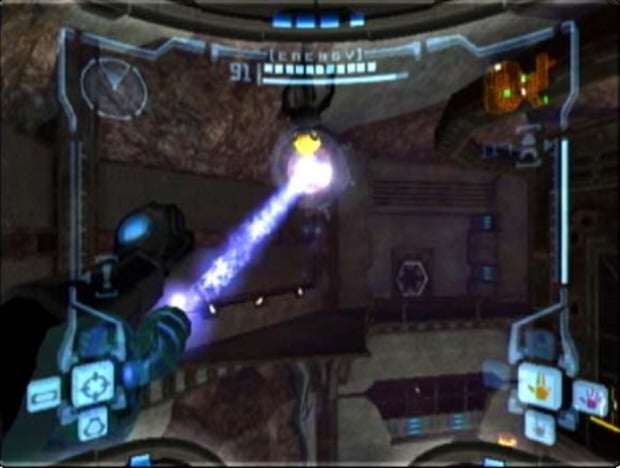
Although Prime is an awesome, brilliant, extremely well-designed, fun game, it isn’t without it’s little glaring issues.
The Scan Visor for example becomes quite overused in a few parts. Near the beginning of the game there are, naturally, a billion things to scan. Although any item that is duplicated only needs to be scanned once (then it’ll appear as still scannable, but faded to inform you that you already scanned it), it still can be quite tiresome to scan so much and so often.
Not to mention intemidating when you first walk in a door and see a ton of orange and red items to scan. Some people will immediatly be turned off by it. And it’s not just the beginning of the game. There is a Space Pirate Lab part in particular where there are literally, I’m not joking, over 100 things to scan within a relative short distance from each other. And while a lot of it is short exposition on this or that, you will also find a ton of Pirate Logs in the mix, and these are several paragraphs long. However, I personally love this aspect of the game. And as I said, none of this is really required to proceed. But it will still rub some people the wrong way.
It can also get very annoying in certain rooms where Space Pirates or other creatures will re-spawn. Although you don’t have to re-fight them in most cases, these encounters get repetitive after a while and the music can grate on your nerves.

My final complaint comes from what are called Chozo Artifacts. These special items are required to reach the end of the game and actually complete it. However unlike most Power-Ups and Items hidden in the game, these little bastards are EXTREMELY well hidden. Half-way through the game you will be lucky if you’ve found three of them, and by the end you will need TWELVE to proceed to the last area of the game. While there are good aspect to the Artifacts (see below) this part can be considered a complaint because of the “fetch quest” nature of having to find the ones you don’t have. Since you will not have all of them by the end, you will be required to go “fetch out” the rest in order to complete the game. Much like the fetch quest at the end of The Legend of Zelda: The Wind Waker, this will turn off some people and may even result in them giving up on finishing the game, since they can be extremely hard to find.
These Chozo Artifacts are probably the most puzzle-heavy aspects of Metroid Prime, although many of the Chozo Artifacts aren’t so much concealed by puzzles as much as they are simply extremely hidden. This means that you can walk by a Chozo Artifact location a hundred times and not realize it is there.
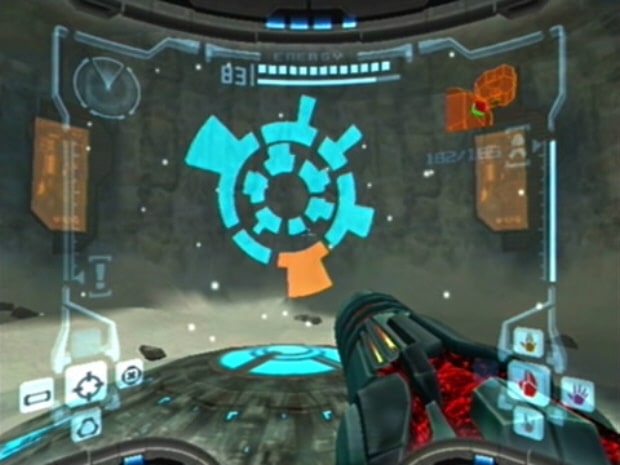
In fact, I remember the first time I ever played Metroid Prime, a couple Chozo Artifacts were so tucked away and hard to find that I literally had to turn to a guide to find the last one. Even now, when reviewing this game, I knew where most of them were but forgot the EXACT spot, and thus had to basically re-find them.
So unless you know EXACTLY where they are located, you can wander for quite a while before finding them. Thankfully in the Log Book Screen under “Artifacts” are hints to each one, as long as you have scanned their corresponding totem poles in the Artifact Temple. Study these clues carefully to discover the hidden location of each Artifact, many of which are in the most unlikely of places. Such as under a body of water, beneath a frozen statue, or accessible only via a tower window that must be busted with heat (yes, I’m giving you hints!).
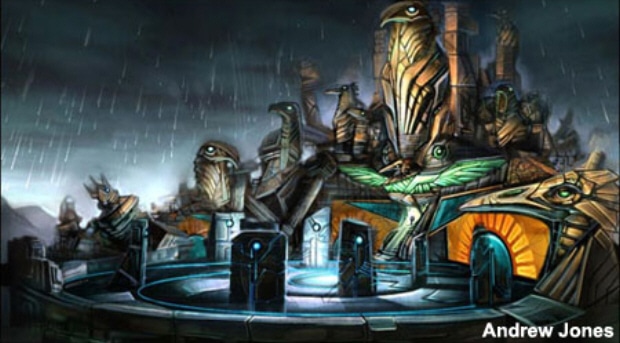
Thankfully items are easier found in Prime if you have a careful ear. Every kind of Power-Up and Item emits a unique whir noise, which you can detect and hear even if you can’t actually SEE the item. This is just another example of the tremendous and outstanding design in Metroid Prime.
Graphically, Prime was a tour-de force back when it first hit in 2002, and even today the game looks really good. Although the graphics themselves won’t blow you away or anything, it is the special effects which really seal the package and make you go “That is COOL.”
As mentioned above, these effects include smoke coming up from you gun if you shoot it too fast (the Power Beam), warped air that appears around a charged shot, and many great effects that encorporate Samus visor and mess with your view. These include green bug blood that will splatter across your visor after destroying certain enemies or is shot at you, condensation that will appear over the screen when being hit by myst or steam, drops of rain that will dot your screen if you look up on the Tallon IV Overworld, and static that will cover the screen if you get too close to an electrically charged enemy.
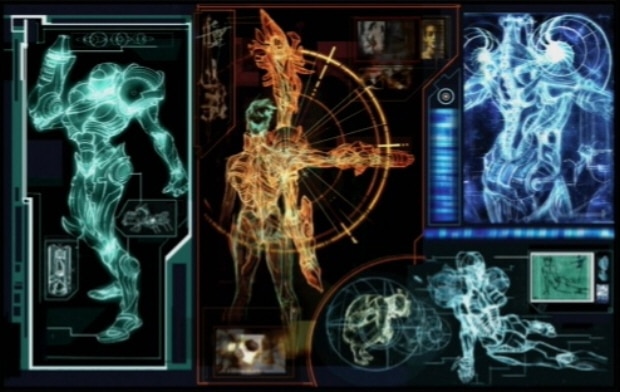
There are even times where your screen can catch so much interference that the display will literally shut off for a few seconds before restarting!
These types of effects are great and really make Prime not only stand out, but impress even now.
As far as sound and music is concerned, Metroid Prime has some great music and the sound effects are not only used well (like the whir from items mentioned above) but is extremely fitting. From the screech of a Metroid to the roar of a Sheegoth to the crackle of your fire, Retro Studios did an amazing job.
As far as extras is concerned, you can unlock a few additional features by linking your GameCube game with Metriod Fusion on the Game Boy Advance via a GCN to GBA Cable. These new features include the ability to play the original Metroid, and a Fusion suit that you get access too. This doesn’t doesn’t actually function different, but makes you look like a 3D version of the oddly proportioned Samus from Metroid Fusion (in the Wii version this feature can be purchased with Tokens and turned on or off. The original Metroid does not appear in the Wii version).
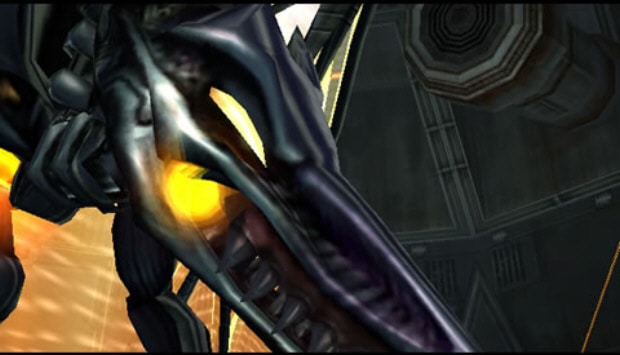
The coolest unlockables come in the form of art galleries for Samus, for enemies and for the environment that you can unlock by gaining a high percentage of completion. The Wii version also has a Sound Test feature which allows you to purchase songs from the soundtrack and listen to them at your leisure.
Since there is SO MUCH to find in Metroid Prime and you can always go for a higher time, not to mention the various difficulties, there is quite a bit of replay value in the game and you will most likely want to play it more than once. Especially since it is nearly impossible to find everything and get a low time on your first play through the game (since the environments are so complex, full of paths here and there, areas tucked into to corners and winding paths).
Overall, Metroid Prime is a masterpiece. This game impresses in every single aspect: Design, Detail, Music, Progression, Exploration, Mood and Feel, Ingenuity-wise . . . I was actually shocked to discover that even in 2009, Metroid Prime is JUST as impressive, fun, challenging and much larger and longer than I remembered it being.
I went in thinking that the game would not hold up in today’s world. I was wrong. PLAY. THIS. GAME.
PERIOD.
FUN FACTOR: 10
Metroid Prime cannot be touched even today. This game is extremely memorable, full of awesome moments, with design and gameplay that is second to none. It is so unique that everyone should play it.
Graphics: 9.5
When you take each individual part of Prime, the game will not “stun” you. But when you add in the extreme detail, the fact that not one two rooms are the same (when the room has what must be over 1,000 individually named rooms), and the extremely unique special effects, you come out with a package that looks just as great now as it did in 2002.
Music and Sound: 9.5
This game features a mostly great soundtrack, with sound effects to match.
Ingenuity: 9.5
Let’s just go through the list: A viewpoint that actually factors into gameplay, that can be covered in condensation, bug blood, lava, raindrops, static, or even shut down . . . . a game world in which no two areas are the same and every area is unique with it’s own environmental puzzles or scannable objects. A control scheme from a first-person perspective that doesn’t include strafing or being able to look up or down or fire while moving (yet it works so well) . . . Metroid Prime was extremely intuitive and ingenious in it’s time, and even now some parts still have yet to be replicated (except in it’s sequels).
Replay Value: 9.5
TONS of stuff to find. Quite a few unlockables, a few only with a certain accessory and a copy of Metroid Fusion. You can even try to get a quicker time for a better ending. While it isn’t endless, it’s a game I have never tired of and still can play through without finding everything 100%. That speaks for itself.
